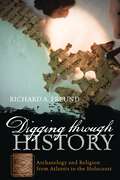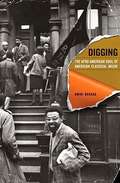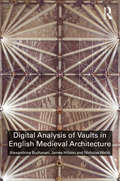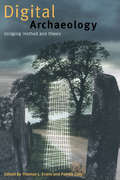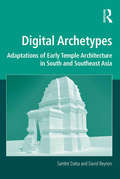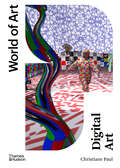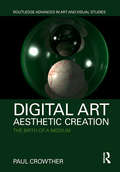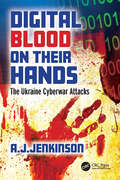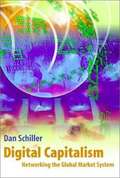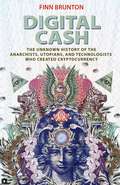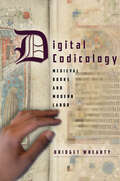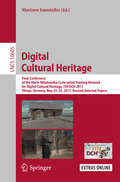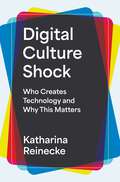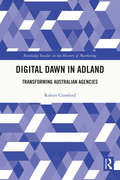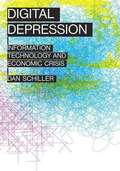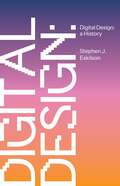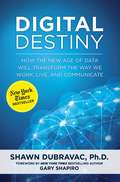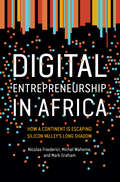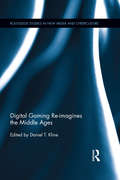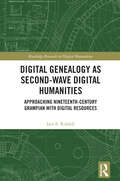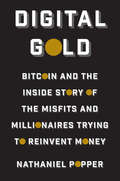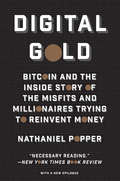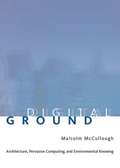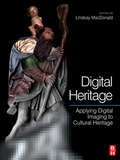- Table View
- List View
Digging through History: Archaeology and Religion from Atlantis to the Holocaust
by Richard A FreundDigging through History follows rabbi and archaeologist Richard Freund's journey through some of the most fascinating archaeological sites of human history—including the mysterious Atlantis, Qumran and the Dead Sea Scrolls, and the long-buried Holocaust camp Sobibor. Each chapter takes readers through a different archaeological site, showing what we can learn about past religious life and religious faith through the artifacts found there, as well as what has given each site such strong "staying power" over time. Richard Freund and the research in Digging through History are featured in the National Geographic documentary Atlantis Rising, which premieres on National Geographic on Sunday, January 29, at 9/8 central. The documentary follows Oscar-winning executive producer James Cameron and Emmy-winning filmmaker Simcha Jacobovici as they investigate the myths and realities of Atlantis. Digging through History is the only book that details Freund’s groundbreaking research on Atlantis that is featured in the f
Digging: The Afro-American Soul of American Classical Music
by Amiri BarakaIn this book on music, the author blends autobiography, history, musical analysis, and political commentary to recall the sounds, people, times, and places he has encountered. He brings home how musicians carry and extend that knowledge with a sense of meaning and belonging.
Digital Analysis of Vaults in English Medieval Architecture
by Nicholas Webb Alexandrina Buchanan James HillsonMedieval churches are one of the most remarkable creative and technical achievements in architectural history. The complex vaults spanning their vast interiors have fascinated both visitors and worshippers alike for over 900 years, prompting many to ask: ‘How did they do that?’ Yet very few original texts or drawings survive to explain the processes behind their design or construction. This book presents a ground-breaking new approach for analysing medieval vaulting using advanced digital technologies. Focusing on the intricately patterned rib vaulting of thirteenth and fourteenth century England, the authors re-examine a series of key sites within the history of Romanesque and Gothic Architecture, using extensive digital surveys to examine the geometries of the vaults and provide new insights into the design and construction practices of medieval masons. From the simple surfaces of eleventh-century groin vaults to the gravity-defying pendant vaults of the sixteenth century, they explore a wide range of questions including: How were medieval vaults conceived and constructed? How were ideas transferred between sites? What factors led to innovations? How can digital methods be used to enhance our understanding of medieval architectural design? Featuring over 200 high quality illustrations that bring the material and the methods used to life, Digital Analysis of Vaults in English Medieval Architecture is ideal reading for students, researchers and anyone with an interest in medieval architecture, construction history, architectural history and design, medieval geometry or digital heritage.
Digital Archaeology: Bridging Method and Theory
by Patrick Daly Thomas L. EvansThe use of computers in archaeology is entering a new phase of unparalleled development, moving on from a specialist methodology on the margins to a powerful practical and analytical tool used across all areas of archaeological interest. With a thorough examination of the ways in which both everyday and cutting-edge technologies can be used to inform and enhance traditional methods, this book brings together ideology from the academic world and pragmatic, concrete examples to show how fieldwork, theory and technology fit together today as never before. Covering a history of the rise of computer use in archaeology as well as a thorough assessment of a number of high profile examples such as the Ferrybridge Chariot, this book shows how new technologies have been implemented into both theory and method as an integral part of the archaeological process. With contributions from renowned experts, experienced professionals and emerging names in the field, this unique, forward-thinking book brings together previously disparate aspects of archaeology in a new holistic approach to the study of the past. A companion website is also available to allow further study of the images included.
Digital Archetypes: Adaptations of Early Temple Architecture in South and Southeast Asia (Digital Research in the Arts and Humanities)
by Sambit Datta David BeynonThis unique book presents a broad multi-disciplinary examination of early temple architecture in Asia, written by two experts in digital reconstruction and the history and theory of Asian architecture. The authors examine the archetypes of Early Brahmanic, Hindu and Buddhist temple architecture from their origins in north western India to their subsequent spread and adaptation eastwards into Southeast Asia. While the epic monuments of Asia are well known, much less is known about the connections between their building traditions, especially the common themes and mutual influences in the early architecture of Java, Cambodia and Champa. While others have made significant historiographic connections between these temple building traditions, this book unravels, for the first time, the specifically compositional and architectural linkages along the trading routes of South and Southeast Asia. Through digital reconstruction and recovery of three dimensional temple forms, the authors have developed a digital dataset of early Indian antecedents, tested new technologies for the acquisition of built heritage and developed new methods for comparative analysis of built form geometry. Overall the book presents a novel approach to the study of heritage and representation within the framework of emerging digital techniques and methods.
Digital Art (World of Art #0)
by Christiane PaulThe fourth edition of the essential introduction to digital art, one of contemporary art’s most exciting and dynamic forms of practice. Digital art, along with the technological developments of its medium, has rapidly evolved from the “digital revolution” into the social media era and then to the postdigital and post-Internet landscape. This new, expanded edition of Christiane Paul’s acclaimed book traces the emergence of artificial intelligence, augmented and mixed realities, and non-fungible tokens (NFTs) and surveys themes explored by digital artworks in the areas of activism, networks and telepresence, and ecological art andthe Anthropocene. It also examines issues surrounding the collection, presentation, and preservation of digital art. It looks at the impact of digital techniques and media on traditional forms of art, such as printing, painting, photography, and sculpture, as well as exploring the ways in which the Internet and software art, digital installation, and virtual reality have emerged as recognized artistic practices. Digital Art is an accessible and engaging text that brings to life individual works, explaining in clear terms how they use technologyto produce artworks with a radical new aesthetic and thematic and interactive qualities. It is an essential critical guide to all forms of digital art.
Digital Art, Aesthetic Creation: The Birth of a Medium (Routledge Advances in Art and Visual Studies)
by Paul CrowtherIs art created with computers really art? This book answers ‘yes.’ Computers can generate visual art with unique aesthetic effects based on innovations in computer technology and a Postmodern naturalization of technology wherein technology becomes something we live in as well as use. The present study establishes these claims by looking at digital art’s historical emergence from the 1960s to the start of the present century. Paul Crowther, using a philosophical approach to art history, considers the first steps towards digital graphics, their development in terms of three-dimensional abstraction and figuration, and then the complexities of their interactive formats.
Digital Blood on Their Hands: The Ukraine Cyberwar Attacks
by Andrew JenkinsonCyberattacks are nothing particularly new to the world and Ukraine had suffered many such attacks by Russia over recent years. Russia had knowingly been exploiting Ukraine’s digital vulnerabilities as a proving ground for nearly a decade. Malware such as Sandworm and BlackEnergy had caused untold damage to the Ukrainian population and government previously, which allowed Russia to perfect cyberattacks for further, more global events. Russia had been planting cyber sleeper digital cells for years, especially in the US and the UK. Then, coincidently, the week after the Chinese Winter Olympic games had finished, Russia launched an all-out cyber offensive against 70 Ukrainian government websites. Owing to these being poorly—and insecurely—maintained, they toppled one by one, causing havoc and disruption to the Ukrainian government and to Ukraine’s critical infrastructure. As Q said in James Bond: ‘I can do more damage by breakfast sipping my Earl Grey tea with my keyboard than you ever can in the field.’ Sadly, Q was right, as we witness daily. The keyboard and mouse have indeed become mightier than the sword. The barrage of cyberattacks against Ukraine constitutes the first cyberwar by one nation against another. This attack crossed a very thin red line. That line had the hallmarks of a nation state, but had until now been confined to cyber criminal activities, immaterial of whom the perpetrators were. This, however, was now war. The cyberwar was simply a precursor, the softening of a country that would precede a kinetic war in which tens of thousands of people would lose their lives. This war was the first war for nearly 80 years that rang out deathly klaxons across Europe and the world. Digital Blood on Their Hands addresses the issues that the digital world has created, covering the culpability, causal links and even liabilities that go towards these war crime atrocities, often too frightening to believe and also too compelling to dismiss. It tells a side to the world’s first ever cyberwar that you would never otherwise see or possibly hear about.
Digital Capitalism: Networking the Global Market System
by Dan SchillerCyberspace not only exemplifies but spearheads the greater political economy of which it has become such a critical part. The networks that comprise cyberspace were originally created at the behest of government agencies, military contractors, and allied educational institutions. However, over the past generation or so, a growing number of these networks began to serve primarily corporate users. Under the sway of an expansionary market logic, the Internet began a political-economic transition toward what Dan Schiller calls "digital capitalism." Schiller traces these metamorphoses through three critically important and interlinked realms. Parts I and II deal with the overwhelmingly "neoliberal" or market-driven policies that influence and govern the telecommunications system and their empowerment of transnational corporations while at the same time exacerbating exisiting social inequalities. Part III shows how cyberspace offers uniquely supple instruments with which to cultivate and deepen consumerism on a transnational scale, especially among privileged groups. Finally, Part IV shows how digital capitalism has already overtaken education, placing it at the mercy of a proprietary market logic.
Digital Cash: The Unknown History of the Anarchists, Utopians, and Technologists Who Created Cryptocurrency
by Finn BruntonThe fascinating untold story of digital cash and its creators—from experiments in the 1970s to the mania over Bitcoin and other cryptocurrenciesBitcoin may appear to be a revolutionary form of digital cash without precedent or prehistory. In fact, it is only the best-known recent experiment in a long line of similar efforts going back to the 1970s. But the story behind cryptocurrencies like Bitcoin and its blockchain technology has largely been untold—until now. In Digital Cash, Finn Brunton reveals how technological utopians and political radicals created experimental money to bring about their visions of the future: protecting privacy or bringing down governments, preparing for apocalypse or launching a civilization of innovation and abundance that would make its creators immortal.The incredible story of the pioneers of cryptocurrency takes us from autonomous zones on the high seas to the world’s most valuable dump, from bank runs to idea coupons, from time travelers in a San Francisco bar to the pattern securing every twenty-dollar bill, and from marketplaces for dangerous secrets to a tank of frozen heads awaiting revival in the far future. Along the way, Digital Cash explores the hard questions and challenges that these innovators faced: How do we learn to trust and use different kinds of money? What makes digital objects valuable? How does currency prove itself as real to us? What would it take to make a digital equivalent to cash, something that could be created but not forged, exchanged but not copied, and which reveals nothing about its users?Filled with marvelous characters, stories, and ideas, Digital Cash is an engaging and accessible account of the strange origins and remarkable technologies behind today’s cryptocurrency explosion.
Digital Codicology: Medieval Books and Modern Labor (Stanford Text Technologies)
by Bridget WheartyMedieval manuscripts are our shared inheritance, and today they are more accessible than ever—thanks to digital copies online. Yet for all that widespread digitization has fundamentally transformed how we connect with the medieval past, we understand very little about what these digital objects really are. We rarely consider how they are made or who makes them. This case study-rich book demystifies digitization, revealing what it's like to remake medieval books online and connecting modern digital manuscripts to their much longer media history, from print, to photography, to the rise of the internet. Examining classic late-1990s projects like Digital Scriptorium 1.0 alongside late-2010s initiatives like Bibliotheca Philadelphiensis, and world-famous projects created by the British Library, Corpus Christi College Cambridge, Stanford University, and the Walters Art Museum against in-house digitizations performed in lesser-studied libraries, Whearty tells never-before-published narratives about globally important digital manuscript archives. Drawing together medieval literature, manuscript studies, digital humanities, and imaging sciences, Whearty shines a spotlight on the hidden expert labor responsible for today's revolutionary digital access to medieval culture. Ultimately, this book argues that centering the modern labor and laborers at the heart of digital cultural heritage fosters a more just and more rigorous future for medieval, manuscript, and media studies.
Digital Cultural Heritage: Progress In Cultural Heritage. Documentation, Preservation, And Protection5th International Conference, Euromed 2014, Limassol, Cyprus, November 3-8, 2014, Proceedings (Theoretical Computer Science and General Issues #8740)
by Marinos IoannidesThis book constitutes the refereed post-conference proceedings of the Final Conference of the Marie Skłodowska-Curie Initial Training Network for Digital Cultural Heritage, held in Olimje, Slovenia, in May 2017.The 29 revised full papers included in this volume were carefully reviewed and selected from 198 submissions. They focus on interdisciplinary and multi-disciplinary research concerning cutting edge cultural heritage informatics, -physics, -chemistry and -engineering and the use of technology for the representation, documentation, archiving, protection, preservation and communication of cultural heritage knowledge.
Digital Culture Shock: Who Creates Technology and Why This Matters
by Katharina ReineckeHow culture shapes the design and use of technology—and how we can resist the one-size-fits-all approach to technology designRobots that encroach on your personal space, baffling emojis, a chatbot that gives you an answer that seems terribly rude—does any of this sound familiar? If so, you may know what it feels like to experience a clash of cultures, or even culture shock, in technology. Culture—shared values, norms, and behaviors—influences both the design of technology and its use. An encounter with new technology can teach us to embrace the unfamiliar, but a mismatch between design and user can create misunderstanding and loss of trust, and can even become a tool of digital imperialism. In Digital Culture Shock, computer scientist Katharina Reinecke travels through countries and cultures around the world to show the many fascinating ways that technology design and use can differ.Reinecke argues that technology is inherently cultural because developers apply their own knowledge and experiences when creating it. And this can make the technology fail in other settings. For example, robotaxis trained on driver behavior on a California highway are paralyzed when confronted with the more complicated traffic flows of Egypt. Western online social networks, designed to convey one&’s individuality, violate the need to preserve the image of a family in more group-oriented cultures. Likewise, the visual complexity common in many East Asian websites can be overwhelming to North Americans and European users, who tend to prefer simpler designs. Making it clear what&’s at stake, Reinecke urges us to resist generalizing our own cultural peccadillos in technology design.
Digital Dawn in Adland: Transforming Australian Agencies (Routledge Studies in the History of Marketing)
by Robert CrawfordDrawing on a unique study of Australian advertising agencies at the dawn of the digital era, this book provides a hitherto unexplored study of the advertising industry at a point of its disruption. By exploring the dynamic interaction between this established but complacent industry, and a radically new communication medium, this book reveals how advertising agencies were forced to change fundamentally, yet as an industry helped shape the digital economy, and the platforms that dominate it. Based on contemporary reports, company archives, personal archives, and over 50 interviews with past and current advertising practitioners across the range of agency departments, this unique historical narrative reveals how power shifts between agencies, advertisers, and other media platforms forged the current models of advertiser-funded digital media. For scholars of marketing, media, communication, and contemporary history, this is an illuminating perspective on the early impact of the digital revolution and its relevance to the media landscape today.
Digital Depression: Information Technology and Economic Crisis (The Geopolitics of Information)
by Dan SchillerThe financial crisis of 2007-08 shook the idea that advanced information and communications technologies (ICTs) as solely a source of economic rejuvenation and uplift, instead introducing the world to the once-unthinkable idea of a technological revolution wrapped inside an economic collapse. In Digital Depression, Dan Schiller delves into the ways networked systems and ICTs have transformed global capitalism during the so-called Great Recession. He focuses on capitalism's crisis tendencies to confront the contradictory matrix of a technological revolution and economic stagnation making up the current political economy and demonstrates digital technology's central role in the global political economy. As he shows, the forces at the core of capitalism--exploitation, commodification, and inequality--are ongoing and accelerating within the networked political economy.
Digital Design: A History
by Stephen EskilsonA groundbreaking history of digital design from the nineteenth century to todayDigital design has emerged as perhaps the most dynamic force in society, occupying a fluid, experimental space where product design intersects with art, film, business, engineering, theater, music, and artificial intelligence. Stephen Eskilson traces the history of digital design from its precursors in the nineteenth century to its technological and cultural ascendency today, providing a multifaceted account of a digital revolution that touches all aspects of our lives.We live in a time when silicon processors, miniaturization, and CAD-enhanced 3D design have transformed the tangible world of cars and coffee makers as well as the screen world on our phones, computers, and game systems. Eskilson provides invaluable historical perspective to help readers better understand how digital design has become such a vibrant feature of the contemporary landscape. He covers topics ranging from graphic and product design to type, web design, architecture, data visualization, and virtual reality. Along the way, he paints compelling portraits of key innovators behind this transformation, from foundational figures such as Marshall McLuhan, Nam June Paik, and April Greiman to those mapping new frontiers, such as Jeanne Gang, Jony Ive, Yugo Nakamura, Neri Oxman, and Jewel Burks Solomon.Bringing together an unprecedented array of sources on digital design, this comprehensive and richly illustrated book reveals how many of the digital practices we think of as cutting-edge actually originated in the analog age and how the history of digital design is as much about our changing relationship to forms as the forms themselves.
Digital Destiny: How the New Age of Data Will Transform the Way We Work, Live, and Communicate
by Gary Shapiro Shawn DubravacOur world is about to change.<P> In Digital Destiny: How the New Age of Data Will Change the Way We Live, Work, and Communicate, Shawn DuBravac, chief economist and senior director of research at the Consumer Electronics Association (CEA), argues that the groundswell of digital ownership unfolding in our lives signals the beginning of a new era for humanity. Beyond just hardware acquisition, the next decade will be defined by an all-digital lifestyle and the “Internet of Everything”—where everything, from the dishwasher to the wristwatch, is not only online, but acquiring, analyzing, and utilizing the data that surrounds us. But what does this mean in practice?<P> It means that some of mankind’s most pressing problems, such as hunger, disease, and security, will finally have a solution. It means that the rise of driverless cars could save thousands of American lives each year, and perhaps hundreds of thousands more around the planet. It means a departure from millennia-old practices, such as the need for urban centers. It means that massive inefficiencies, such as the supply chains in Africa allowing food to rot before it can be fed to the hungry, can be overcome. It means that individuals will have more freedom in action, work, health, and pursuits than ever before.
Digital Entrepreneurship in Africa: How a Continent Is Escaping Silicon Valley’s Long Shadow
by Mark Graham Nicolas Friederici Michel WahomeThe hope and hype about African digital entrepreneurship, contrasted with the reality on the ground in local ecosystems.In recent years, Africa has seen a digital entrepreneurship boom, with hundreds of millions of dollars poured into tech cities, entrepreneurship trainings, coworking spaces, innovation prizes, and investment funds. Politicians and technologists have offered Silicon Valley-influenced narratives of boundless opportunity and exponential growth, in which internet-enabled entrepreneurship allows Africa to "leapfrog" developmental stages to take a leading role in the digital revolution. This book contrasts these aspirations with empirical research about what is actually happening on the ground. The authors find that although the digital revolution has empowered local entrepreneurs, it does not untether local economies from the continent's structural legacies.
Digital Games as History: How Videogames Represent the Past and Offer Access to Historical Practice (Routledge Advances in Game Studies)
by Adam ChapmanThis book provides the first in-depth exploration of video games as history. Chapman puts forth five basic categories of analysis for understanding historical video games: simulation and epistemology, time, space, narrative, and affordance. Through these methods of analysis he explores what these games uniquely offer as a new form of history and how they produce representations of the past. By taking an inter-disciplinary and accessible approach the book provides a specific and firm first foundation upon which to build further examination of the potential of video games as a historical form.
Digital Gaming Re-imagines the Middle Ages (Routledge Studies in New Media and Cyberculture)
by Daniel T. KlineDigital gaming’s cultural significance is often minimized much in the same way that the Middle Ages are discounted as the backward and childish precursor to the modern period. Digital Gaming Reimagines the Middle Ages challenges both perceptions by examining how the Middle Ages have persisted into the contemporary world via digital games as well as analyzing how digital gaming translates, adapts, and remediates medieval stories, themes, characters, and tropes in interactive electronic environments. At the same time, the Middle Ages are reinterpreted according to contemporary concerns and conflicts, in all their complexity. Rather than a distinct time in the past, the Middle Ages form a space in which theory and narrative, gaming and textuality, identity and society are remediated and reimagined. Together, the essays demonstrate that while having its roots firmly in narrative traditions, neomedieval gaming—where neomedievalism no longer negotiates with any reality beyond itself and other medievalisms—creates cultural palimpsests, multiply-layered trans-temporal artifacts. Digital Gaming Re-imagines the Middle Ages demonstrates that the medieval is more than just a stockpile of historically static facts but is a living, subversive presence in contemporary culture.
Digital Genealogy as Second-Wave Digital Humanities: Approaching Nineteenth-Century Grampian with Digital Resources (Routledge Research in Digital Humanities)
by Iain E. RiddellIn the first major engagement with Aberdeenshire’s rural society since Carter’s The Poor Man’s Country of 1979, Riddell’s study of Northeast Scotland encourages readers to consider the vast potential held by Digital Genealogy for second-wave Digital Humanities.Often overlooked in contemporary historical scholarship, this study carves out a place for Digital Genealogy in academia. Riddell constructs a new lens to examine rural society in the nineteenth century, through which he extends and challenges Carter’s analysis. In recovering a breadth of people and their social networks through prosopographical data, the book reveals the agency of individuals who left minimal records. Riddell not only puts forward a fresh perspective on the social structures of Scotland’s north-eastern society but also informs a discussion on the nature of Britishness both within concepts of a developed western civilisation and beyond them.This book will interest a broad readership; Scottish history enthusiasts, pursuers of Digital Genealogy and, scholars and students of the Digital Humanities will all find value in this study.
Digital Gold
by Nathaniel PopperBitcoin, the landmark digital money and financial technology, has spawned a global social movement with utopian ambitions. The notion of a new currency, maintained by the computers of users around the world, has been the butt of many jokes, but that has not stopped it from growing into a technology worth billions of dollars, supported by the hordes of followers who have come to view it as the most important new idea since the creation of the internet.Believers from Beijing to Buenos Aires see the potential for a financial system free from banks and governments, and a new global money for the digital age. An unusual tale of group invention, Digital Gold tells the story of the colorful characters who have built Bitcoin, including a Finnish college student, an Argentinian millionaire, a Chinese entrepreneur, Tyler and Cameron Winklevoss, Bitcoin's elusive creator, Satoshi Nakamoto, and the founder of the Silk Road online drug market, Ross Ulbricht.With Digital Gold, New York Times reporter Nathaniel Popper offers a brilliant and engrossing account of this new technology--one filled with dramatic booms and busts that have led to untold riches for some and prison terms for others. But at each step of the way, Bitcoin has provided one of the most fascinating tests of how money works, who benefits from it, and what it might look like in the future.
Digital Gold: Bitcoin and the Inside Story of the Misfits and Millionaires Trying to Reinvent Money
by Nathaniel PopperA New York Times reporter&’s &“vivid&” account of the dramatic rise of Bitcoin and how it has led to untold riches for some—and prison terms for others (Financial Times). Shortlisted for the Financial Times and McKinsey Business Book of the YearA New York Times Book Review Editor&’s Choice The notion of a new currency, maintained by the computers of users around the world, has been the butt of many jokes, but that has not stopped it from growing into a technology worth billions of dollars, supported by the hordes of followers who have come to view it as the most important new idea since the creation of the Internet. Believers from Beijing to Buenos Aires see the potential for a financial system free from banks and governments. More than just a tech industry fad, Bitcoin has threatened to decentralize some of society&’s most basic institutions. An unusual tale of group invention, Digital Gold charts the rise of the Bitcoin technology through the eyes of the movement&’s colorful central characters, including an Argentinian millionaire, a Chinese entrepreneur, Tyler and Cameron Winklevoss, and Bitcoin&’s elusive creator, Satoshi Nakamoto. &“Engrossing.&” —Library Journal &“An elegant, thrilling tour-de-force. . . .The fast-paced action never stops.&” —William D. Cohan, New York Times–bestselling author of Power Failure
Digital Ground: Architecture, Pervasive Computing, and Environmental Knowing
by Malcom McclloughDigital Ground is an architect's response to the design challenge posed by pervasive computing. One century into the electronic age, people have become accustomed to interacting indirectly, mediated through networks.
Digital Heritage
by Lindsay MacDonaldIn the fields of documentation and conservation of cultural heritage assets, there is a constant need for higher quality records and better analytical tools for extracting information about the condition of artefacts. Digital photography and digital image processing provide these capabilities, and recent technological advances in both fields promise new levels of performance for the capture and understanding of colour images. This inter-disciplinary book covers the imaging of decorated surfaces in historical buildings and the digitisation of documents, paintings and objects in museums and galleries, and shows how user requirements can be met by application of powerful digital imaging techniques. Numerous case studies illustrate the methods.
